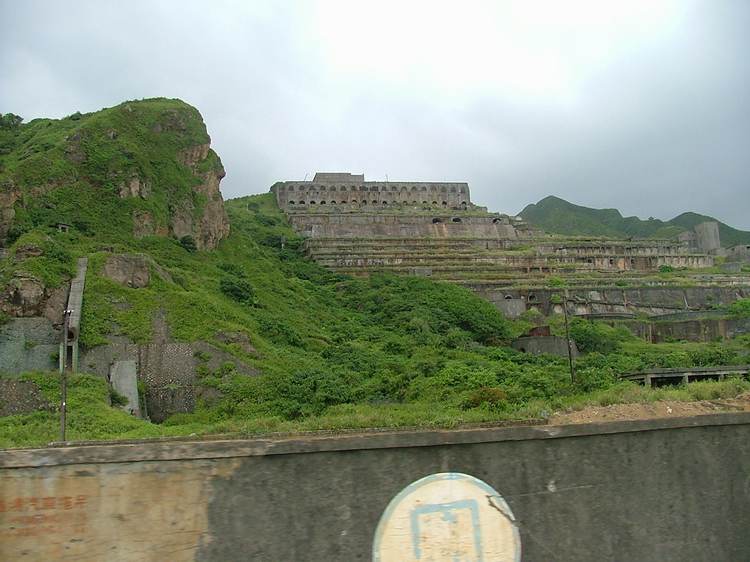Saturday Around Keelung
Keelung is one of Taiwan's most interesting areas, containing both important yet not widely known historic sites, and interesting hikes and history. as well as stunning mountain scenery and hundreds of cozy mountain communities. One Saturday we stayed at a friend's house to visit a small but historic reservoir, Taiwan's first, and then the mining region south of Keelung.
back to Teaching English in Taiwan

Saturday morning dawned bright and unusually clear, with good views of the mountains in the Keelung area. To the left is a local apartment complex.

We decided to head for a small local reservoir to enjoy a quiet morning walk. This colorful spider, washed out in the stark morning sun, greeted us as we parked our car.

Taiwanese often gather in groups to exercise in the dawn air. Here a group of women does tai chi under the dam.

The reservoir dates from the Japanese period, like much of Taiwan's basic infrastructure. Much early pathway and stonework remains, along with a few old buildings.

Another colorful spider waits for breakfast.

The reservoir at peace in the still morning air.

Dan-dan and Zeb discuss the days' doings.

Yet another glorious spider.

This picture resulted from an amazing piece of luck. I only wanted the flower, and just as I snapped the picture, this moth alighted on the blossom.

A wolf spider in camo hunts across the sandy soil.

An early bird finds a solitary spot for exercise.

Morning glories greet the sun.

The early moth gets the.....

This spider, a little smaller than my hand, has an eerie inverted Death's Head on its body.

Croquet, a sport well suited to a sedate early morning.

We ran into one of the small mountain communities. Jeff observed that one of the pleasures of the mountains is that they break up the brutally monotonous carpet of humanity on the west coast plain into pleasantly cozy communities.

A popular, and therefore good, restaurant.

Typical breakfast fare.

After breakfast we headed down to the coast. The mountains on the east coast come right down to the sea, and the steep gradient makes for some imposing views.

On the coast, looking up.

The area we explored lies to the interior, to the west, of this colossal wreck, a copper processing facility. Copper ore was mined in the mountains, first in underground mines, and then in open cuts after the underground ore was exhausted in the late 1970s. The ore was processed here. Mining began here under the Japanese, who derived 20% of their prewar supply of copper from the area. Gold and gems are also found nearby.

A waterfall above the processing facility passes over copper-stained rock.

The pipe at the top of this picture is not, as one might imagine, a slurry for bringing in ore to the factory. It is actually part of a smokestack system that vents the fumes from copper processing out of the valley. It is the world's longest smokestack, according to the local museum, stretching 2 kilometers.

A small community on the coast.

We turned into the mountains and headed up, leaving the coast behind, except for the amazing views.

We headed up to Gold Ecological Park in a nearby mountain community.

A temple. The east coast mountains, with their excellent feng shui, are dotted with temples.

Allied prisoners of war from the camp here worked in the copper mines during WWII.

Taipei County Gold Ecological Park. Tickets are $100 to get in. The park is built around the old gold mining and refining operation.

Tourist traps in the park.

The old refining building. Restoration work is ongoing.

The county has erected a fine little museum with displays in Chinese and excellent, though not native speaker, English.

The gold mining operation began under the Japanese. The crown prince's villa is located on-site.

Where to next, mom?

Kids collect a stamp at each stop and then can trade them in for a toy. Quickly collecting stamps became more important than learning or viewing.

Beautiful critters everywhere.

Where do the steps go? Zeb finds out.

The crown prince's villa. Those concrete shapes -- are they pavilions? Building Foundations? Hint: the prince had a fondness for miniature golf.

Although this looks like a sign about poisonous snakes, it is actually a warning not to accidentally swallow the giant mutant tapeworms that inhabit the area. So it is perfectly safe to walk here. Really. No snakes at all. No sirree.....*

One of the tunnel openings has been covered with a museum and displays. The ticket for the tunnel is separate so we didn't go in.

An air compressor for the mine.

I guess if there was an ominous reduction, the head mining engineer lost his job immediately. An explanation of how gold is separated from copper in the ore contains an obvious English error, rare for the otherwise high quality presentation.

Inside the Gold Museum, a sign makes an astounding claim that I have never heard before.

This exhibit allows you to lift a 12.5 kilogram gold bar. The sign prohibits foreigners from making the attempt, but it is written only in Chinese. We ignored it, of course.

Tara and Dan-dan pose by a massive 220 kg block of gold.

The scenery is excellent.

Some of the local wildlife sidles by.

There's a sausage vendor at every attraction. If only the sausage was as varied as the rest of the food.

Stopping by a hole-in-the-wall for some beef noodle on the way home.